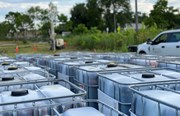Why In Situ Thermal Remediation Should be Considered for Treatment of MGP Sites
By: John LaChanceRemediation of former manufactured gas plant (MGP) sites typically targets removal of coal tar and creosote by excavating and disposing of impacted soils at off-site landfills. Other times, soils are treated in an on-site or off-site ex situ thermal desorption unit. Excavation and ex situ thermal treatment, however, is not always feasible or desirable due to site access limitations, odor and noise concerns in urban settings, and the potential for traffic accidents and fatalities associated with the increased truck traffic.
In those cases, in situ thermal remediation (ISTR) can be an excellent alternative. In this blog post, I’ll explain why.
If you’re interested in learning more about treating MGP sites and have questions you’d like me to address, register for next week’s webinar, What You Need to Know About Thermal Remediation for MGP Sites. I’ll explain in more detail about the criteria you should be using to determine if ISTR is right for your project site, and provide some examples of how thermal technologies worked in real life.
Thermal Treatment Options
There are three ISTR technologies that can be used to treat MGP sites: electrical resistance heating (ERH), thermal conductive heating (TCH), and steam enhanced extraction (SEE). Choosing the right one depends on site geologic and hydrogeologic conditions, the nature of the MGP wastes being targeted, and the remedial goals. All three technologies can be used to heat the target treatment volume to ~100°C, which enhances and facilitates four key mass removal mechanisms:
- Reduces the viscosity of the NAPL and makes it more pumpable
- Increases the volatilization of volatile contaminants
- Stream strips higher boiling point compounds
- Causes the desorption of contaminants
Treating MGP sites to 100°C using these technologies, combined with aggressive multi-phase extraction of vapors and liquids (water and NAPLs), can be an effective solution for removing mobile LNAPL and DNAPL. It can also remove the volatile fraction from the remaining mass (e.g., BTEX and naphthalenes) and lock up the remaining mass in an immobile fraction that does not result in a risk to groundwater or indoor air.
Complicated Sites
Not all projects are that straightforward, though, and some may require a more tailored solution. For example, if the complete removal of TPH and achievement of stringent soil standards for contaminants like PAHs are required, TCH may be the best solution—as it can be used to heat the treatment zone to 300 to 350°C, addressing the contaminants with a higher boiling point.
There are potential challenges with this approach, however. It requires that the targeted treatment interval is above the water table or, if it is below the water table, that groundwater flux into the treatment zone can be controlled (e.g., pumping, sheet pile, or slurry wall). The absence of flowing groundwater is required, since achieving >>100°C requires boiling off all the water present in the target treatment zone first. This is certainly achievable, but must be factored into the project planning.
Reduced Risks & Costs
Using ISTR solutions for MGP sites reduces risks involved with excavation and transportation of soils, but it also has the potential to reduce costs. A well planned remedy uses a conceptual site model (CSM) to identify the best technology for each treatment zone, and targets each with the most appropriate and cost effective remediation option. ISTR also shortens the treatment timeline, reducing costs associated with personnel or lost opportunity for site usage.
If you would like to learn more or have questions about working on MGP sites, register for tomorrow’s webinar, What You Need to Know About Thermal Remediation for MGP Sites.
ABOUT THE AUTHOR

John LaChance
Vice President, Thermal Technology
[email protected]
John LaChance has more than 30 years of experience in the assessment, design and implementation of remediation systems at hazardous waste sites, including 18 years working in in situ thermal remediation (ISTR). He has evaluated and worked on hundreds of sites in the United States, Brazil, China, Australia and several European countries. Mr. LaChance has also led research efforts on how to use sustainable energy and geothermal techniques to gently heat sites to speed up biological and abiotic reaction rates, and has been actively involved with the development and delivery of new methods and approaches for thermal remediation. He has authored several papers and presentations on ISTR and the hydrogeology of DNAPL sites, and is a co-founder of and presenter at ISTR workshops around the globe.

